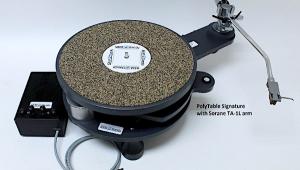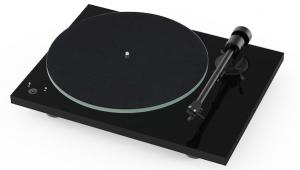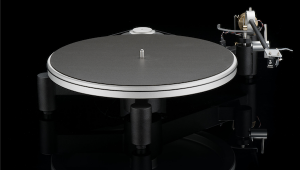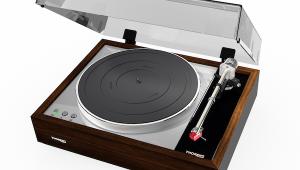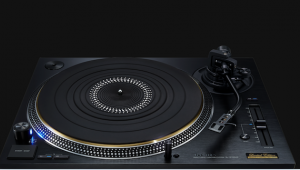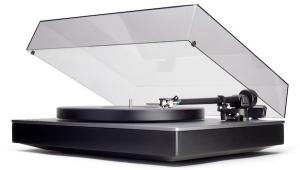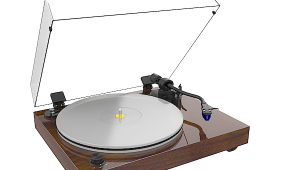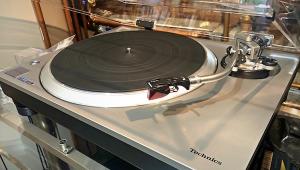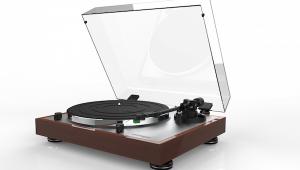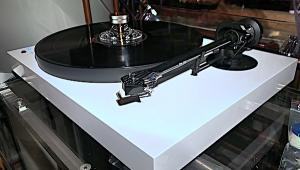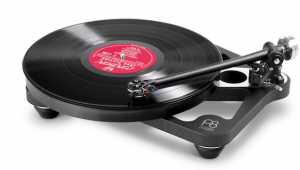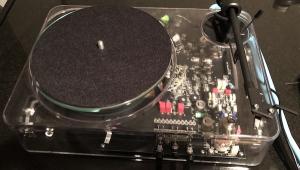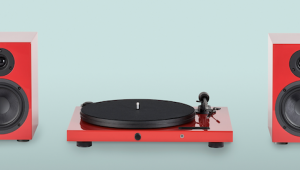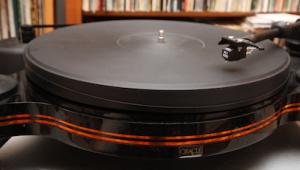In my experience, the precision of the Rockport Technologies System III Sirius turntable and tonearm is comparable to that of a duct making machine. For a closer look, visit here and see how audio quality and manufacturing craftsmanship work together.
Rockport Technologies System III Sirius turntable and tonearm Page 4
Air is supplied to the System III Sirius via an industrial-duty two-head compressor. The system includes an active refrigeration/accumulator that cools and removes moisture from the warm, compressed air, and provides a stage of pulse filtration. The air is then filtered and precision-regulated to 30psi. A 50' air line (which does double duty as a remote power On) is provided so the not-too-noisy, suitcase-sized compressor can be located well away from the listening environment.
Setup and Use
Once the System III Sirius was assembled and was only waiting to be fired up, I just shook my head at its beauty, obvious functionality, and freedom from tiny little dangling parts. Cartridge installation and fine-tuning were easier than with any other arm I've used. I'll spare you the details.
Once that was accomplished, I simply pushed a switch and, within a few minutes, the +200-lb plinth had risen on a bed of air supplied by the air-suspension system. I had to level it pneumatically via three small knurled knobs. This is critical—the frictionless arm will slide in toward the record center or out the other way if the 'table isn't precisely leveled. In fact, the only way to level it correctly is to counterbalance the arm/cartridge with a temporary counterweight (I made one from a pipe cleaner and a wood screw). Once it is floating, so you can see which way it wants to go. When the arm is set correctly, and the tracking force is set to zero, it will remain where you put it on the rail.
Then it was time to play a record. I put one on the platter, where it rested on the high-hysteresis, mineral-filled alloy, coated with a pebbly proprietary material intended to minimize unwanted vibrations at the record surface by absorbing and dissipating them as heat. The material has another important property: When the vacuum holddown is applied, it deforms slightly, allowing particles of dust and dirt to be embedded in it instead of in the record's grooves.
With the record on the platter, I pushed the vacuum button. The record flattened and became one with the platter. I pushed the appropriate speed button and the 'table was at full speed in a second or two. I slid the arm across to the lead-in groove, lowered the cueing lever—which will conveniently stop anywhere in its travel—and off I went!
Despite the technological brilliance behind it, the System III Sirius has to be among the easiest, no-fuss record players I've ever used or dreamed of using.
Could This Be Magic?
Although I was mightily impressed with the System III Sirius's design and superlative build quality, I didn't begin listening in a seriously snowed state of mind. In fact, I was skeptical. I had owned the Rockport Series 6000 arm, and while it was the best arm I'd ever heard above 100Hz, its less than stellar bass performance (once I'd heard the Immedia RPM2 and the Graham 2.0) forced me to switch to the unipivot designs, despite their shortcomings in other areas compared to the Rockport. As the Duke wrote, "It don't mean a thing if it ain't got that swing."
Unfortunately for me, it took only about 30 seconds of the first tune I played—for some reason, a lacquer of Dave Mason's Only You Know and I Know—to hear that the Rockport Sirius III, which I probably will never be able to afford, was, in every way, laughably better than anything else I'd ever heard.
Forget for a minute about the details. The Sirius III's overall presentation of the music was so much bigger, more focused, solid, three-dimensional, surefooted, dynamic, and seamless than anything else I've ever heard, that I lost my footing. Literally. I was floored! I had to sit down and cool off. You know that musical sensation of "slow," when something is more precise and focused? I was certain the Rockport was spinning way slow. But it wasn't. When I played the most complex musical mixes, every tiny detail became a major event sorted out in both time and three-dimensional space. Every minute stroke of stick on cymbal became a monument in time. This 'table produced forward motion and drive like nothing else I've ever heard...except live music.
Any concerns about the Sirius III's bass performance were quickly alleviated. I threw at it the best bass material I had, in terms of both extension and subtle textures, and it was immediately apparent that the Sirius III had all of the extension of the Graham and Immedia arms, as well as the most supple and correctly controlled midbass I've ever heard, with no overhang or bloat. Record after record revealed the most natural drum sound I've ever heard. The drums on Robbie Robertson's Fallen Angel had "skin" as I've never heard from that disc, and astounding focus and three-dimensionality.
A friend—a mastering and recording engineer with an exceptionally good studio system that includes Aerial 10Ts—came over with Sting's Nothing Like the Sun. He swore that he knew every lick and musical note on "Englishman in New York," and wanted to hear what $75,000 got you. At the end, he knew. "I heard licks I never knew were there, and now I know what brand of skins were on those drums. I never could tell that before."
- Log in or register to post comments


It's incredible, but the price tag puts it squarely in the "dream machine" category for most of us. Maybe ChatGPT could generate a list of more budget-friendly turntables that still offer excellent sound quality.


